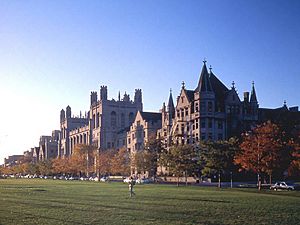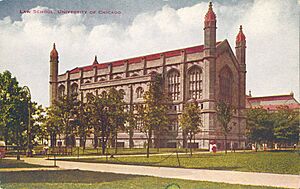University of Chicago Law School facts for kids
Quick facts for kids University of ChicagoLaw School |
|
|---|---|
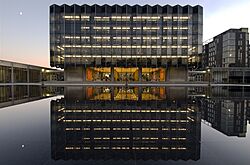 |
|
| Parent school | University of Chicago |
| Established | 1902 |
| School type | Private law school |
| Dean | Adam Chilton |
| Location | Chicago, Illinois, U.S. |
| Enrollment | 626 (2021) |
| Faculty | 183 (2021) |
| USNWR ranking | 3rd (2025) |
| Bar pass rate | 97.9% (2020) |
| ABA profile | Standard 509 Report |
 |
|
The University of Chicago Law School is a famous law school that is part of the University of Chicago. It's a private university located in Chicago, Illinois. Many teachers work here, over 180 of them. More than 600 students study to become lawyers in its main program. The school also offers other advanced law degrees.
The law school first started in Stuart Hall, a beautiful old building. Since 1959, it has been in a modern building designed by Eero Saarinen. This building has been made bigger and updated over the years.
Many important people have taught at the law school. These include famous legal thinkers like Cass Sunstein and Richard Posner. Even former U.S. President Barack Obama taught here. Several U.S. Supreme Court justices, like Antonin Scalia and Elena Kagan, were also teachers.
Contents
The Law School's Story: How It Began
Starting a New Law School in Chicago
When the University of Chicago began in 1892, its president, William Rainey Harper, wanted to create a law school. He hoped it would help make government better. Harper believed that democracy needed strong leaders.
He asked many experts for advice. One professor suggested the new school should train students to be "leaders of the bar." This meant they would become excellent lawyers and judges. Another adviser thought the school should focus on how law affects society. A legal scholar named Ernst Freund suggested mixing law with other subjects. This included history and political science. Harper agreed that studying law should include understanding people and society.
In 1901, Harper announced the law school would open the next year. He got help from Harvard Law School. Its dean allowed Professor Joseph Henry Beale to be the first dean in Chicago. Harvard wanted Chicago to have similar high standards. Harper hired Freund, and the school's plan included his ideas. The first teachers came from other top universities.
Opening and Early Years
The law school opened its doors on October 1, 1902. It was in the University Press Building. John D. Rockefeller paid for the building. President Theodore Roosevelt even helped lay the first stone.
When it opened, 78 students were enrolled, including two women. The school taught basic law subjects like contracts and criminal law. It also offered advanced courses. The University of Chicago Law School was one of the first to offer the J.D. degree. This degree required students to have a college degree first. Its library quickly grew to 18,000 law books. By 1903, student numbers increased to 126.
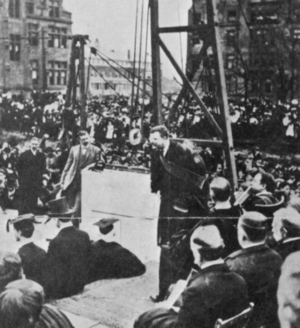
The law school did very well in its early years. It connected with experts in other fields like economics and history. It also worked with Chicago lawyers who taught practical courses. The school's quality was seen as equal to Harvard's. In 1904, the law school moved to Stuart Hall. That same year, Sophonisba Breckinridge became the first woman to graduate from the school. She noted that the school treated men and women equally.
The school saw many changes around World War I. Student numbers dropped a lot during the war. In 1920, Earl B. Dickerson became the first African-American to graduate. The school's Black Law Students Association is named after him. After the war, in 1926, enrollment reached 500 students. The school's long-serving dean, James Parker Hall, passed away in 1928.
Growing with New Ideas and Edward Levi's Leadership
In the 1930s, new dean Harry A. Bigelow continued to mix law with other subjects. He added classes in accounting and economics. The idea of "law and economics" became very important. Experts like Aaron Director and Henry Calvert Simons started teaching economics courses in 1933.
The first issue of the University of Chicago Law Review was published in 1933. The school also started a legal writing program in 1938. The LL.M. program, for advanced law students, began in 1942. Like during World War I, student numbers went down during World War II.
In the 1950s and 1960s, the law school grew a lot under Edward Hirsch Levi. He became Dean in 1950. Many important scholars joined the faculty, including Karl Llewellyn and Soia Mentschikoff. Mentschikoff was the first woman to teach at the school. From 1953 to 1955, future Supreme Court Justice John Paul Stevens taught here.
In 1958, the Journal of Law and Economics was started. In 1959, the law school moved to its current building. This building was designed by Eero Saarinen. In 1960, the Supreme Court Review was founded. Edward Levi later became the president of the University of Chicago. He then served as the United States Attorney General for the U.S. President.
Late 20th Century Developments
By the 1970s and 1980s, the "law and economics" idea attracted many scholars. These included Nobel Prize winners Ronald Coase and Gary Becker. Famous legal thinkers like Richard A. Posner also joined. In 1972, Posner started the Journal of Legal Studies.
The law school also created programs where students could earn two degrees at once. For example, they could combine law with public policy or economics. In 1982, the Federalist Society was started by students here and at other law schools. By 1989, the D'Angelo Law Library had over 500,000 books.
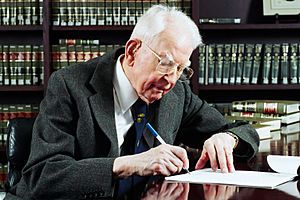
Many scholars who became leaders in their fields joined the faculty during this time. Richard A. Epstein, a very influential legal thinker, joined in 1973. Cass Sunstein, one of the most cited legal scholars, began teaching here in 1981. Former U.S. Supreme Court Justice Antonin Scalia was a professor from 1977 to 1982. His future Supreme Court colleague, Elena Kagan, also started her career here. The 44th U.S. President, Barack Obama, taught constitutional law at the school from 1992 to 2004.
What Students Learn and How They Learn It
The law school has over 200 full-time and part-time teachers. About 600 students are in the main J.D. program. The school also offers advanced law degrees like the Master of Laws (LL.M.). Students can even combine their law degree with a business degree or a Ph.D.
Professors at the law school often use the Socratic Method. This means they ask students questions without warning. They present made-up situations and keep asking questions. This helps students think deeply about the law. It's one of the few law schools that uses this teaching style. The small number of students per teacher helps with this method.
Law Clinics: Learning by DoingThe law school has seven legal clinics. In these clinics, students get school credit while practicing law. They work under the guidance of experienced lawyers. Some of these clinics include:
|
Research Centers: Exploring New IdeasThe law school has six research centers. These centers host events and speakers all year. They help explore new ideas in law. Some centers focus on:
|
Policy Initiatives: Making a DifferenceThe law school has several policy initiatives. These projects work on important issues. Some past and current initiatives include:
|
Special ProgramsThe law school offers special programs for students interested in specific areas. These include:
|
D'Angelo Law Library: A Place to Study
The D'Angelo Law Library is part of the larger University of Chicago library system. It was updated in 2006. The library has a large reading room on the second floor. It is open many hours each week. It has study spaces for about 500 people. The library also has Wi-Fi and computers. It holds over 700,000 books. About 6,000 new books are added every year. These include materials in over 25 languages.
Getting In and Paying for School
In 2021, the law school accepted 175 students. Over 6,500 people applied that year. This means about 12% of applicants were accepted. Students who get in usually have very good test scores and grades.
The total cost to attend the law school in 2017–18 was over $93,000. This included tuition, fees, and living expenses.
How Grades Work
The law school uses a special grading system. Grades are on a scale from 155 to 186. For most classes, the average grade is set at 177. This system helps keep grades fair.
Students can graduate "with honors" for good grades. "With high honors" and "with highest honors" are for even better grades. Getting "highest honors" is very rare. The top 10% of graduating students are chosen for the Order of the Coif. Other honors are given to students with top grades in their first or second years.
Publications: Sharing Legal Ideas
The law school produces seven professional journals. These journals share new legal ideas. Four of them are run by students:
- the University of Chicago Law Review (one of the most cited law reviews)
- the Chicago Journal of International Law
- the University of Chicago Legal Forum
- the University of Chicago Business Law Review
Three journals are overseen by teachers:
- the Supreme Court Review
- the Journal of Law and Economics
- the Journal of Legal Studies
The law school also publishes academic papers. These papers share research on different legal topics.
Student Groups: Getting Involved
There are about 60 student-run groups at the law school. These groups are part of the Law Students Association. The school is home to one of the first chapters of the Federalist Society. Former Supreme Court Justice Antonin Scalia helped start this chapter. There is also a large chapter of the progressive American Constitution Society for Law and Policy.
The Law School Campus
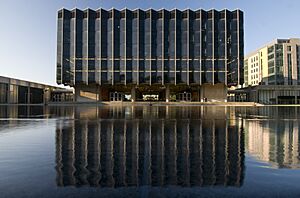
The law school first started in Stuart Hall. In October 1959, it moved to its current building. This building was designed by Eero Saarinen. It has classrooms, the D'Angelo Law Library, and offices. The buildings are arranged around a fountain. This design is similar to the older buildings on campus. Many important people visited for the opening.
In 1987, the building was made bigger. More office and library space was added. In 1998, a special area for the law school's clinics was built. The library and other parts of the building were updated in 2008. Most of Saarinen's original design was kept.
Important People from the Law School
Deans Who Led the School
- Joseph Henry Beale (1902–1904)
- James Parker Hall (1904–1928)
- Harry A. Bigelow (1929–1939)
- Wilber G. Katz (1939–1950)
- Edward H. Levi (1950–1962)
- Phil C. Neal (1963–1975)
- Norval Morris (1975–1979)
- Gerhard Casper (1979–1987)
- Geoffrey R. Stone (1987–1993)
- Douglas Baird (1994–1999)
- Daniel Fischel (1999–2001)
- Saul Levmore (2001–2009)
- Michael H. Schill (2010–2015)
- Thomas J. Miles (2015–2025)
- Adam Chilton (2025–present)
Famous Teachers
The law school has had many famous teachers. These include the 44th U.S. President Barack Obama. Also, Supreme Court Justices Antonin Scalia, John Paul Stevens, and Elena Kagan taught here. Other notable teachers include Karl Llewellyn, Walter J. Blum, and Cass Sunstein. Current teachers include Nobel Prize winner Martha Nussbaum and legal philosopher Brian Leiter. Federal judges Frank H. Easterbrook and Diane P. Wood also teach at the school.
Current Teachers
- Daniel Abebe: expert on constitutional and international law
- Douglas Baird: expert on bankruptcy law
- William Baude: expert on constitutional law
- Omri Ben-Shahar: expert on contracts and consumer protection
- Emily Buss: expert on children's rights
- Frank H. Easterbrook: U.S. circuit judge and antitrust expert
- Richard A. Epstein: expert on classical liberalism and law and economics
- Tom Ginsburg: expert on international and comparative law
- Richard H. Helmholz: legal historian
- Alison LaCroix: legal historian and constitutional law expert
- William Landes: economist and law and economics expert
- Brian Leiter: legal philosopher
- Saul Levmore: former Dean and expert on commercial law
- Martha Nussbaum: famous philosopher
- Eric Posner: expert on international and contract law
- Richard A. Posner: former federal judge and highly cited legal scholar
- Geoffrey R. Stone: leading expert on constitutional law
- Diane P. Wood: Chief U.S. circuit judge
Former Teachers
- Harry A. Bigelow
- Walter J. Blum
- Gerhard Casper
- Ronald Coase: Nobel Prize winner in economics
- Aaron Director
- Ernst Freund
- Elena Kagan: Justice of the Supreme Court of the United States
- Harry Kalven
- Nicholas Katzenbach: former U.S. Attorney General
- Karl Llewellyn
- Edward Levi: former U.S. Attorney General
- Michael W. McConnell
- Bernard D. Meltzer
- Soia Mentschikoff
- Abner Mikva
- Barack Obama (1992–2004): former President of the United States
- Roscoe Pound
- Antonin Scalia: former Justice of the Supreme Court of the United States
- Henry Simons
- John Paul Stevens: former Justice of the Supreme Court of the United States
- Cass Sunstein
Notable Graduates
The law school has many distinguished graduates. They have become leaders in law, government, business, and other fields. These include heads of state, judges, and government officials. Many have founded major law firms or led large companies.
In the judiciary, graduates include Lord Thomas, a top judge in England and Wales. Also, Shimon Agranat, a former President of the Supreme Court of Israel. Several federal appellate judges in the U.S. graduated from here, like Douglas H. Ginsburg and Frank H. Easterbrook.
In government and politics, notable graduates include former U.S. Attorneys General John Ashcroft and Edward H. Levi. The former Prime Minister of New Zealand, Geoffrey Palmer, also graduated here. Other graduates include former FBI director James Comey and current U.S. Senator Amy Klobuchar.
Graduates who are leaders in education include Christopher L. Eisgruber, the current president of Princeton University. Also, Larry Kramer, former Dean of Stanford Law School.
In business, famous graduates include billionaire David Rubenstein, who founded the Carlyle Group. Also, Adam Silver, the current commissioner of the NBA. Katherine L. Adams, the general counsel of Apple Inc., is also a graduate.
The law school's alumni also include four recipients of the Presidential Medal of Freedom. Two Pulitzer Prize winners also graduated from here. Other notable alumni include Carol Moseley Braun, the first African-American woman U.S. Senator. Also, Sophonisba Breckinridge, the first woman to graduate from the law school.


